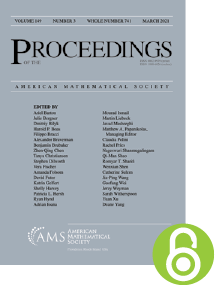Soft almost disjoint families
HTML articles powered by AMS MathViewer
- by Paul J. Szeptycki PDF
- Proc. Amer. Math. Soc. 130 (2002), 3713-3717 Request permission
Abstract:
An almost disjoint family $A$ is said to be soft if there is an infinite set that meets each $a\in A$ in a nonempty but finite set. We consider the associated cardinal invariant defined to be the minimal cardinality of an almost disjoint family that is not soft. We show that this cardinal coincides with J. Brendle’s cardinal $\mathfrak {ap}$.References
- Jörg Brendle, Dow’s principle and $Q$-sets, Canad. Math. Bull. 42 (1999), no. 1, 13–24. MR 1695894, DOI 10.4153/CMB-1999-002-2
- Winfried Just, Mikhail V. Matveev, and Paul J. Szeptycki, Some results on property (a), Topology Appl. 100 (2000), no. 1, 67–83. Special issue in honor of Howard H. Wicke. MR 1731705, DOI 10.1016/S0166-8641(98)00134-5
- Paul J. Szeptycki and Jerry E. Vaughan, Almost disjoint families and property (a), Fund. Math. 158 (1998), no. 3, 229–240. MR 1663330, DOI 10.4064/fm-158-3-229-240
- Stevo Todorčević, Partition problems in topology, Contemporary Mathematics, vol. 84, American Mathematical Society, Providence, RI, 1989. MR 980949, DOI 10.1090/conm/084
Additional Information
- Paul J. Szeptycki
- Affiliation: School of Analytic Studies and Information Technology, York University, Toronto, Ontario, Canada M3J 1P3
- Email: szeptyck@yorku.ca
- Received by editor(s): September 15, 2000
- Received by editor(s) in revised form: July 25, 2001
- Published electronically: May 14, 2002
- Additional Notes: The author received partial support from NSERC grant 238944.
- Communicated by: Alan Dow
- © Copyright 2002 American Mathematical Society
- Journal: Proc. Amer. Math. Soc. 130 (2002), 3713-3717
- MSC (2000): Primary 03E17, 54A25, 54D20
- DOI: https://doi.org/10.1090/S0002-9939-02-06487-0
- MathSciNet review: 1920052


